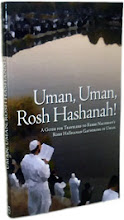By Dovid Sears
Based on selections from Likutey
Halakhos and other Breslov works, as found in Rabbi Noson Zvi Kenig’s Siddur
Shaarey Ratzon, “Kavanos Kriyas Shema,” pp. 203-205 (Bnei Brak,
first edition).
L’ilui nishmas imi morasi Gittel bas
Ida, a”h, whose yahrtzeit was 5 Adar II.
We recently discussed several kavanos—“intentions,”
or in this case, conceptual frameworks—for the “Kedushah” in the communal
prayer service. Another key part of the davening, whether we are in or
out of shul, that deserves our attention is the “Shema.” (I remember
reading that Rabbi Dov Ber, the “Mittler Rebbe” of Lubavitch, once said, “The deeper
one’s ‘Shema,’ the deeper one’s Shemoneh Esreh”—or something similar. I no
longer have the source.)
Here we will sum up a few Breslov
teachings that can serve as kavanos when one recites the “Shema.” Like
virtually all Breslov teachings, they are excerpts from larger contexts—either lessons
from Likutey Moharan, sections of Reb Noson’s Likutey Halakhos, which are based
on lessons in Likutey Moharan, or other Breslov works. Thus, to understand
these teachings about the “Shema,” we also need to understand their
underpinnings. We’ll do the best we can to sum them up.
"Hear, O Israel: the Lord [Y-H-V-H] our God, the Lord [Y-H-V-H] is one" (Deuteronomy 6:4).
שְׁמַע
יִשְׂרָאֵל ה' אֱלֹהֵינוּ ה' אֶחָד
1 Bringing Down the Light
Reb Noson cites the Arizal, who states that the kabbalistic intention when reciting the “Shema” is to unify Abba and Ima (the sefiros of Chokhmah and Binah), thus to “draw down” the higher mentalities (“mochin”) to the lower sefiros. To the uninitiated, the meaning of this is obscure. But in Chassidic fashion, Reb Noson brings the Kabbalah down to earth—or at least, he heads in that direction. Reb Noson expounds on the Arizal’s principle as it applies to the person performing the mitzvah, and how it affects that person’s spiritual condition and state of mind: By reciting the Shema, we express our faith in G-d’s unity and in so doing, gain a more vivid spiritual sense of that unity.
Reb Noson cites the Arizal, who states that the kabbalistic intention when reciting the “Shema” is to unify Abba and Ima (the sefiros of Chokhmah and Binah), thus to “draw down” the higher mentalities (“mochin”) to the lower sefiros. To the uninitiated, the meaning of this is obscure. But in Chassidic fashion, Reb Noson brings the Kabbalah down to earth—or at least, he heads in that direction. Reb Noson expounds on the Arizal’s principle as it applies to the person performing the mitzvah, and how it affects that person’s spiritual condition and state of mind: By reciting the Shema, we express our faith in G-d’s unity and in so doing, gain a more vivid spiritual sense of that unity.
However, Reb Noson adds, we still
have not been privileged to reveal G-d’s malkhus (kingship) to all
humanity. This universal revelation is the ultimate purpose of the tzimtzum
(constriction of the Infinite Divine Light) at the beginning of creation,
which will be fulfilled in the time of Mashiach. We contribute to this redemptive
knowledge every time we recite the Shema and accept G-d’s malkhus upon ourselves,
particularly by contemplating and revealing G-d’s unity when we pronounce the
word “echad.”
This tikkun still requires
that we “draw down” the light of that Divine Unity to the level of the middos
(i.e., the “emotional traits” that parallel the seven lower sefiros).
This is accomplished by our overcoming foolish and evil thoughts with holy and
good thoughts. Then when we serve G-d in a measured way, “one step at a time,”
we imbue ourselves with G-d’s malkhus and reveal it to all the world.
This is also the theme of the two
paragraphs of “vi-ahavtah” and “vi-hayah im shamo’a” that we
recite after the Shema. That is, after bringing about the “yichuda ila’ah”
(“upper unification,” as the Zohar describes the Shema), we accept the “yoke of
the kingdom of heaven” by expressing our love of G-d, and by guarding against
evil thoughts (as in “hishamru lakhem pen yifteh levavkhem vi-sartem…”)—for
all evil thoughts are aspects of the Evil Inclination and idolatry. Then we
recite the third paragraph about the tzitzis (fringes on four-cornered
garments) and the tekheiles (blue string), which the Zohar
describes as destroying all evil. This empowers our struggle to overcome evil
thoughts with good thoughts, and thus reveal G-d’s malkhus.
The same tikkun is reflected
in the declaration that follows the Shema: “Barukh shem kevod malkhuso
li-olam va’ed,” “Blessed be the name of His glorious kingship forever” (an
addition of Chazal based on the verse "Blessed be
His glorious name," Psalm 72:19).
The Shema represents what Rebbe
Nachman calls “beisa ila’ah,” the “upper house,” while “barukh shem
kevod” represents “beisa tata’ah,” the “lower house.” (These in turn
correspond to the upper and lower letters “heh” in the Four-Letter Name yud-heh-vav-heh,
and the Supernal Jerusalem and Earthly Jerusalem—corresponding to the sefiros
of Binah and Malkhus.) Through this tikkun of the “lower house,” we
merit to reveal G-d’s malkhus to all humanity, even to those who are
extremely far from holiness. This reflects the Gemara’s teaching that “Barukh
Shem” is recited in a whisper because it is analagous to the tasty burnt remnants
at the bottom of a pot (“tzikey kedeirah”) that the Princess craves,
although it is beneath her station—therefore, her servant must provide it to
her “on the sly” (Pesachim 56a). [That is, according to this line of
interpretation, the Shekhinah desires the service of those who are unworthy, as
well as those who are righteous] (Abridgement of Likutey Halakhos, Hil. Minchah
7, sec. 73-74, based on Likutey Moharan I, 49; see there.)
2 Everything is Included in the “Shema”
Rabbi Nachman Goldstein, one of the youngest disciples
of Reb Noson, who later became the Rav of Tcherin and the leading Breslov
scholar of his generation, discusses the Shema in his Chassidic chiddushim
on Shulchan Arukh, “Nachas ha-Shulchan” (the entire sefer being
based on the first lesson in Likutey Moharan).
There, he states that all the kavanos of
reciting the Shema are incorporated in the simple belief in G-d’s Unity and
Oneness—that G-d is the One Authority, Ruler, and Overseer of all that exists;
He transcends all things, and there is nothing higher than Him.
This includes all of the kavanos, which (as
stated above) are to “draw down” all of the mochin (higher
“mentalities,” namely Chokhmah and Binah) when we recite the Shema, thus to
unite the Holy One (“Kud’sha Brikh Hu,” the Zohar’s term for G-d’s
transcendent aspect) and the Shekhinah (G-d’s immanent aspect).
That is, it is necessary to elicit all aspects of mystical
knowledge (Da’as) and higher consciousness into the simple faith in G-d’s
Oneness, may He be blessed (Nachas ha-Shulchan, Orach Chaim sec. 48).
We hope to return to this subject in
the next posting, im yirtza Hashem.














No comments:
Post a Comment